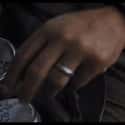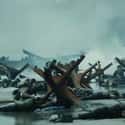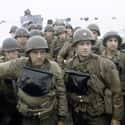-
(#12) Soldiers Often Collected Dirt As A Symbol Of Where They'd Served
Tom Sizemore's character, Sergeant Horvath, is seen gathering soil from France and placing it in a tin. When he puts the small container in his bag, there's a glimpse of similar tins labeled Italy and Africa, indicating he's collected dirt and sand from those locations, as well.
What Horvath does in Saving Private Ryan was common for WWII soldiers. Many men who served took home souvenirs. Talismans like soil, seashells, and rocks taken from the places they served functioned as a special reminder of survival. Such items could also become a source of good luck.
When Frank Gagliano, a member of the 101st Airborne who stormed Omaha Beach on D-Day, revisited Normandy decades after the invasion, he actually grabbed some sand to take home with him. Gagliano noted, "I didn't think to do it the first time... I was too busy trying to stay alive."
-
(#6) Soldiers Did Throw Mortar Shells During WWII
In one scene in Saving Private Ryan, Matt Damon throws a mortar shell, an action that actually led to many individuals who watched the movie crying foul. According to naysayers, no soldier would have ever thrown such a dangerous piece of ammunition.
There are accounts of soldiers doing just that, however. Technical Sergeant Beauford T. Anderson received a Congressional Medal of Honor for his service during WWII, with a citation that read in part:
He seized an enemy mortar dud and threw it back among the charging [Japanese], killing several as it burst. Securing a box of mortar shells, he extracted the safety pins, banged the bases upon a rock to arm them and proceeded alternately to hurl shells and fire his piece among the fanatical foe, finally forcing them to withdraw.
Chuck "Commando" E. Kelly also earned a Congressional Medal of Honor, having "picked up 60-mm mortar shells, pulled the safety pins, and used the shells as grenades, killing at least five of the enemy" while serving in Italy in 1943.
-
(#3) The Anti-Seacraft 'Czech Hedgehogs' In The Water At Normandy Reflect One Of The Miscalculations Made By The Germans
The presence and placement of Czech hedgehogs at Normandy - crossed bars of iron or steel welded into spiky obstacles - gives insight into preparations for the invasion by the Germans. Often used to disable tanks, the Czech hedgehogs were an ideal defense against landing vessels, as well. When underwater, approaching boats and ships would be struck.
Germany believed the invasion of Normandy by Allied Forces was going to take place at high tide. The Allied Navy and Army, however, opted to begin their approach in the early morning hours of June 6, 1944, when the tide was low. This gave them time to disable some of the underwater defenses installed by the Germans.
-
(#11) Spielberg Attached Drills To The Cameras To Simulate The Shaking And Disruption Of Explosions
Steven Spielberg thought he was onto something when he attached drills to his camera to make it shake, testing "a Black & Decker drill taped to a Panaflex camera so the image would vibrate whenever I turned on the drill."
The goal was to recreate the impact of an explosion and, according to key grip Jim Kwiatkowski, it worked:
...the best boy, Bob Anderson, attached an electric drill to the pan handle of a fluid head and locked an oblong bolt with an eccentric washer in the chuck. When activated, it created a wobbling movement and the camera shake we wanted.
In the end, cinematographer Janusz Kaminski realized, "It's a great effect, but you certainly can't handhold the camera with a drill attached to it. Plus, your eye is constantly bopping against the viewfinder." He and Spielberg opted for a lens that created the same effect, "only without having someone with a 90-yard extension cord running behind the camera."
-
(#5) The Soldiers In The Movie Wore Unfastened Helmets
Throughout Saving Private Ryan, soldiers are shown wearing helmets with chinstraps either hanging by the sides of their heads or fastened in the back. During WWII, it was common for men to leave their M1 helmets - made of an outer steel shell and an inner liner - unfastened due to concern among soldiers that a chinstrap would be dangerous in an explosion. The fear was that the force from the blast would blow one's helmet back, breaking the wearer's neck in the process.
It was reported that General George S. Patton even ordered men to leave their helmets unfastened after one of his aides perished in Tunisia in this exact manner.
-
(#2) Only Sounds From Authentic WWII Weapons Were Used
To add to the realistic feel that sets Saving Private Ryan apart from other war movies, sound effects engineers sought out WWII weapons and vehicles in order to record and incorporate them into the film.
Sound designer Gary Rydstrom hoped to recreate the sounds of WWII, having been told by Steven Spielberg that he "didn't want cliches... there might be a lot of cheating in sound effects from the classic war movies," and there was to be none of that "cheating" in this film.
In addition to gunfire from WWII machine guns and rifles, the sound of bullets underwater accompanied the representation of temporary hearing impairment caused by the overwhelming noise of battle.
New Random Displays Display All By Ranking
About This Tool
Our data comes from Ranker, If you want to participate in the ranking of items displayed on this page, please click here.






